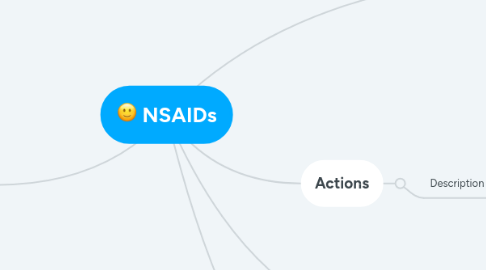
1. Drug Types
1.1. Acetic Acids
1.1.1. Diclofenac
1.1.2. Etodolac
1.1.3. Indomethacin
1.1.4. Ketorolac
1.1.5. Nabumetone
1.1.6. Sulindac
1.1.7. Tolmetin
1.2. COX-2 Inhibitors
1.2.1. Celecoxib
1.3. Fenamates
1.3.1. Meclofenamate
1.3.2. Mefenamic acid
1.4. Oxicam Derivates
1.4.1. Meloxicam
1.4.2. Piroxicam
1.5. Propionic Acids
1.5.1. Fenoprofen
1.5.2. Flurbiprofen
1.5.3. Ibuprofen
1.5.4. Ketoprofen
1.5.5. Naproxen
1.5.6. Oxaprozin
1.6. Salicylates
1.6.1. Aspirin
1.6.2. Diflunisal
1.6.3. Magnesium salicylate
1.6.4. Salsalate
2. Enzymes/Proteins
2.1. Examples
2.1.1. Cyclooxygenase 1 (COX-1)
2.1.1.1. Constitutive with many homeostatic roles
2.1.1.2. It's inhibition causes most adverse effects of NSAIDs
2.1.2. Cyclooxygenase 2 (COX-2)
2.1.2.1. Inducible during inflammation
2.1.3. Clycooxygenase 3 (COX-3)
2.1.3.1. A variant of COX-1
2.2. Description
2.2.1. COX is an enzyme used to form prostaglandins & thromboxane from arachidonic acid
3. Actions
3.1. Description
3.1.1. Block Cyclooxygenase which is used by the body to make Prostaglandins. By reducing production of prostaglandins, NSAIDs help relieve the discomfort of fever and reduce inflammation and the associated pain.
4. Examples
4.1. Aspirin
4.2. Ibuprofin
4.3. Celecoxib
4.4. Ketoprofen
4.5. Naproxen
5. Where they are derived from
5.1. Fenamic Acid
5.1.1. Anthrillic Acid
